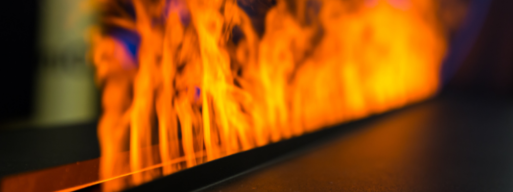Everything You Need to Know About Gas Fireplaces and Venting Systems
As the weather gets colder, mental images of curling up by the fire with a good book (or a great person) start to sound more appealing. So if you have space for it, why don’t you turn those fireplace fantasies into a reality?
Gas fireplaces make for a cozy and preferred option when it comes to adding some ambiance to a household, and this modern method of old-school heating isn’t as difficult a dream to achieve as you would think it is.
Read More: Comprehensive Guide on Why You Should Opt for a Gas Fireplace
What is a gas fireplace?
In layman’s terms, gas fireplaces use natural gas, which is a safe, energy-efficient, and environmentally-friendly way to add warmth and comfort to your home. By using your home’s natural gas lines, installation is efficient and quick. You can also be in complete control of the height of the flame and temperature, with the power to choose between blazing blue fires and little crackles as soothing background noise.
Different Types of Gas Fireplaces
If you want flames, but don’t want to deal with the messy cleanup that comes with traditional wood fireplaces, then the main types of gas fireplaces are a natural gas fireplace, insert, or stove is the perfect fit for you. We’re happy to help you decide which is the best to choose, considering the type of venting your home can handle, and what your aesthetic goals are.
Read More: Questions to Ask Yourself Before Installing a New Fireplace
Gas Fireplace
Say goodbye to fetching logs and kindle, making messes and having to poke around at bits of newspaper to create large, intimidating flames. Gas fireplaces are a better option for most modern indoor spaces because they burn natural gas instead of wood, and they are also easy to install as they use natural gas lines in the house. You can also fully control their temperature and flame height. They are chic, durable, and mess and hassle-free. No more ashes, and they don’t even require a chimney.
Gas Fireplace Insert
If you’re lucky enough to have an existing built-in fireplace and wanted to modernize it by switching to gas, look into gas-inserts. Gas-inserts are installed within the original fireplace, converting it to an energy-efficient gas fireplace. These are especially ideal for replacing a drafty masonry fireplace with one that won’t let most of its heat out through the chimney.
You could also opt for gas logs if you have an existing fireplace, such as this model of gas logs from Burning Log in Ottawa. Gas logs are extremely easy and are an insert in their own way. They also add to the traditional aesthetic a rustic fireplace has to offer.
Gas Stoves
Gas stoves are a charming and vintage feature that could add an interesting aesthetic to any room. They’re also versatile and, when combined with the proper venting system, can be put anywhere in the room. They may need a chimney or another more sophisticated venting system, but they’re lovely to look at and be near, providing another type of traditional aesthetic.
Types of Gas Fireplace Vents
We’ve talked a lot about vents in this article, but now it’s about time to really explain them. Because if you are going to opt for a gas fireplace, you’re going to need to learn about venting systems. Any gas fireplace you have, whether it’s built-in or external, will need a vent system. Venting systems keep everything safe by expelling all the build-up of the gas fireplace while keeping the air in your room clean. Here are the types of vents to consider.
Read More: Fireplace Venting Explained
Direct Vent
Direct-vents are straightforward in that they draw outdoor air for combustion, then expel spent air to the outside through a dual (or co-linear) venting system, eliminating the heat loss associated with conventional chimneys. If you don’t have an existing chimney, they can be vented up through the roof or out to the side or back of a house. But, it’s important the direct-vent system has a sealed glass door to maintain proper combustion and ensure efficiency and indoor air quality.
Natural Vent
Natural vents utilize an existing chimney to exhaust combustion by-products within the room to the outside using a flexible liner installed within the chimney. Similar to this gas stove fireplaces we offer at Burning Log, this is what it would look like.
Power Vent
A power vent (also regularly known as a PV) is the most sophisticated option when it comes to fireplace vent systems. PVs are also versatile because, with it, you can have your fireplace installed in almost any location without the need for a vent running vertically from the top of the unit. It also gives you room to install your fireplace wherever you wish, even in areas of your house that you didn’t think possible.
Fireplace in the bathroom? Why not! Also, PVs are efficient in heating your home since a fan-powered accessory is positioned along the vent, and the air exchange is enhanced significantly, enabling the vent to run longer and cover more areas of your space.
Which Option Should You Choose?
Before you make your choice, we can all agree that gas fireplaces are truly superior to traditional ones. There are so many options, however, and the best choice really boils down to how your home is structured to accommodate such a feature. You can go with the cuteness and complexity of a stove, the artistic freedom of a gas fireplace with a PV, or repurpose that gorgeous built-in fireplace feature that came with the house and hasn’t been used in years. Either way, get ready to make some cozy new memories and (believe it or not) look forward to winters to come with your brand-new gas fireplace.

